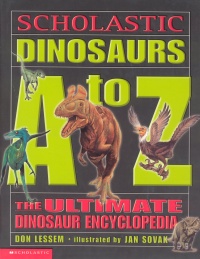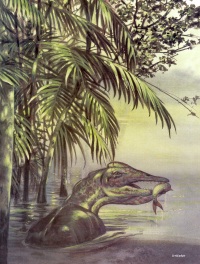| ________________
CM . . .
. Volume XI Number 2 . . . . September 17, 2004
excerpt:
As author or co-author of more than two dozen books for children, many of them on dinosaurs, Lessem is well qualified to write this book. In fact, he co-authored a similar work for a youthful and adult audience in 1993: The Dinosaur Society's Dinosaur Encyclopedia (Random House). With Scholastic Dinosaurs A to Z, he comes close to achieving his ambitious goal of creating a children's reference book describing every known dinosaur. In the end, he falls hundreds of entries short of the 900+ different kinds of dinosaurs known. Twenty-three preliminary pages provide important background material that explains how the book is organized. It includes excellent information about dinosaurs: what they are, when and where they lived, what happened to them, how they are discovered, and more crucial to the rest of the book, how they are named, and how they are grouped. Classifying dinosaurs into two taxa or groups (once called orders), three major sub-groups, twenty-six smaller groups (families), genus, and sometimes species, is a complex business. Change in the terminology and inconsistent use, even by the author, doesn't make it any clearer. Nevertheless, the introductory matter concludes with a very good summary of the characteristics of the twenty-six small groups, each of which is given a unique icon that will help visual learners to readily identifying this level of classification. Subsequent entries in the alphabetical section that comprises the bulk of the book, are arranged by the dinosaurs genus name, but include the icon for the higher level in the classification scheme. Unfortunately, the dinosaur family-tree on page 21 is not only inadequately labelled, but it also omits one small group (ceratosauria) from the theropoda branch, and also misplaces the group spinosauria with the sauropodomorpha branch instead of the therapoda where it belongs. This shortcoming is relatively minor as the work is a major accomplishment. The sample entry displayed above illustrates the information provided for more than 450 genera or kinds of dinosaurs, from Abelisaurus to Zuniceratops. The text is presented in two columns, with illustrations found on virtually every page. Lessem also includes more than 300 brief entries for invalid dinosaur names, with cross-references to the valid entries as in the following example: Trachodon (track-uh-don) Not a valid scientific name. First named from only a few teeth, then used as a grab-bag name for many duck-billed dinosaurs until they were more clearly identified. See Hadrosaurus, Edmontosaurus, and Anatotitan. More than fifty percent of the entries for valid dinosaur names include a full-colour illustration. In cases where the dinosaur is well-documented, Jan Sovak tends to depict the entire animal, sometimes on a full-page. In many instances, only a headshot or a single bone, with notable characteristics showing, represents the artists interpretation of how the dinosaur may have appeared. Because of the paucity of information about flesh textures and colouring, artistic license is a given. Some 26 sidebars containing anecdotes about palaeontologists or miscellaneous facts are scattered throughout the A-Z listing, but located in proximity to a dinosaur named in the anecdote. These stand out because of their green background and caption titles on purple headers. The inclusion of researchers from around the world in these asides helps to emphasize the global nature of the study of dinosaurs. The book includes a four-page glossary with illustrations. It is not always clear which entry corresponds to the illustration. For example, does the headshot of Chirostenotes illustrate the word camouflage, or, carnivore? Finally, the book concludes with a brief list of resources, including books, videos, favourite web sites, museums, and paleontological expeditions. Almost all of the books and videos are less than ten years old. Only three museums are identified (two American, one Canadian) but web-savvy kids will find more resources. Scholastic Dinosaurs A to Z should be in all public libraries, and larger junior/intermediate schools. This work has a great deal of potential beyond that of a reference tool. Hopefully libraries will allow this book to circulate and will not just keep it in the noncirculating reference collection. Highly Recommended. Val Ken Lem is a catalogue librarian at Ryerson University, Toronto, ON.
To comment
on this title or this review, send mail to cm@umanitoba.ca.
Copyright © the Manitoba Library Association. Reproduction for personal
use is permitted only if this copyright notice is maintained. Any
other reproduction is prohibited without permission.
NEXT REVIEW |TABLE OF CONTENTS FOR THIS ISSUE
- September 17, 2004.
AUTHORS
| TITLES | MEDIA REVIEWS
| PROFILES
| BACK ISSUES
| SEARCH | CMARCHIVE
| HOME |

 ed-mon-toe-sor-uhs
ed-mon-toe-sor-uhs